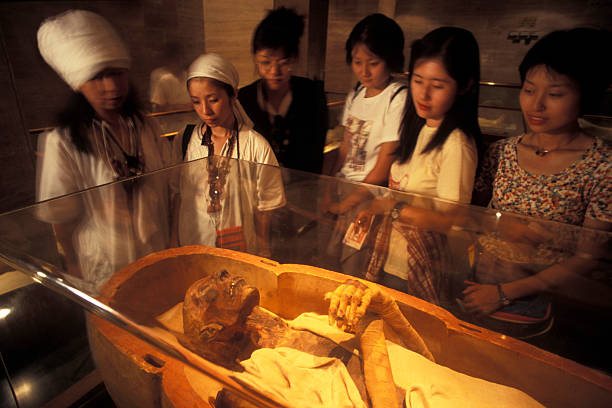The mummy of Ramesses II was among those discovered in the Royal Cache (TT320) at Deir el-Bahari, an ancient Egyptian site known for its hidden tombs and burial chambers. When archaeologists found the mummy, it was entirely wrapped in linen bandages adorned with the king’s name and royal titles inscribed in Hieratic script. The mummy’s hair, once silky and white at the time of his death, had turned yellow due to the chemicals used during the mummification process. Resin and seeds had been placed inside his nostrils, possibly to help maintain their shape during the embalming process. This meticulous preservation reflected the ancient Egyptians’ belief in the afterlife and their dedication to ensuring the body’s integrity for eternity.

Originally, Ramesses II was laid to rest in a grand tomb within the Valley of the Kings, a royal necropolis located on the west bank of the Nile near Thebes. This burial site, reserved for pharaohs and nobles, was intended to protect the deceased from tomb raiders and preserve their journey to the afterlife. However, as tomb looting became increasingly common during the late New Kingdom period, priests took measures to safeguard the bodies of revered kings. To prevent desecration, Ramesses II’s mummy was transferred to the tomb of Queen Inhapy. Yet, after only three days, it was moved once again—this time to the tomb of Pinedjem II, a high priest of Amun. This sequence of relocations is documented in inscriptions found on the linen wrappings that envelop the pharaoh’s body, offering modern researchers a glimpse into the challenges of preserving royal remains during ancient times.
Ramesses II, often regarded by historians as one of Egypt’s most powerful and influential rulers, reigned for approximately six decades, from around 1279 to 1213 BC. His long and prosperous reign earned him the epithet “Ramesses the Great.” Known for his military conquests, extensive building projects, and diplomatic achievements, Ramesses II solidified Egypt’s dominance in the region. He is believed to have fathered over 100 children, a testament to his prolific lineage, which helped secure the continuity of the royal bloodline. Living well into his nineties—a remarkable age for the time—Ramesses II’s longevity contributed to his legendary status, as few rulers of the ancient world matched his extended reign and enduring influence.
The rediscovery of Ramesses II’s mummy in 1881 marked a pivotal moment in Egyptology. Archaeologists unearthed the royal cachette at Deir el-Bahari, which contained the mummies of more than 50 kings, queens, and high-ranking officials, including Seti I, the father of Ramesses II. The cachette had been used by ancient priests to conceal the bodies of esteemed rulers, ensuring their protection from grave robbers who sought to plunder the riches buried with the dead. The discovery not only provided invaluable insights into ancient Egyptian burial practices but also offered a rare opportunity to study the physical remains of one of history’s most renowned pharaohs.
Nearly a century after its discovery, the mummy of Ramesses II faced a new challenge: preservation against modern threats. By 1974, experts observed that the mummy’s condition was deteriorating due to fungal infections that threatened to damage the ancient remains. To halt the deterioration, Egyptian authorities decided to transport the mummy to Paris, where advanced conservation techniques could be applied. In a remarkable display of international cooperation, the French government issued an official Egyptian passport for Ramesses II, listing his occupation as “King (deceased).” This document was required for customs purposes, as French law mandated that any human remains entering the country must be properly documented. This unique passport became a symbol of both the pharaoh’s enduring legacy and the respect accorded to him by modern nations.
Upon arrival in Paris, a team of scientists and conservators conducted extensive examinations to assess the mummy’s condition. X-rays revealed that Ramesses II had suffered from several age-related ailments, including severe arthritis in his hip joint and advanced dental problems, which would have caused considerable pain during his later years. These findings aligned with historical records suggesting that the pharaoh experienced declining health in his final decades. The preservation efforts in Paris successfully halted the fungal infection, ensuring that the mummy would be protected from further decay. Following the completion of these treatments, Ramesses II’s mummy was returned to Egypt, where it was placed in a climate-controlled environment designed to maintain its stability for future generations.
The mummy of Ramesses II continues to be a source of fascination for researchers and the public alike. Its well-preserved state has allowed scientists to gain insights into the health, lifestyle, and physical characteristics of one of ancient Egypt’s greatest rulers. The yellowed hair, although altered by mummification chemicals, serves as a reminder of the pharaoh’s advanced age at the time of his death. The presence of resin and seeds in his nostrils exemplifies the meticulous techniques employed by ancient embalmers, who sought to preserve the body’s natural appearance for its journey into the afterlife. These details not only highlight the sophistication of ancient Egyptian funerary practices but also provide a tangible connection to a figure whose reign shaped the course of history.
Today, Ramesses II’s mummy is housed in the National Museum of Egyptian Civilization in Cairo, where it is carefully preserved and displayed for visitors from around the world. Its presence serves as a testament to the enduring legacy of a ruler who left an indelible mark on ancient Egypt through his military prowess, architectural achievements, and cultural contributions. The story of his mummy’s discovery, preservation, and global journey reflects the ongoing efforts of archaeologists, scientists, and conservators to safeguard the treasures of the past for future generations. By studying the remains of Ramesses II, researchers continue to unlock new insights into the life and times of a pharaoh whose influence still resonates more than three millennia after his death.





